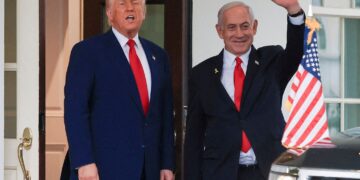(Corrects milestone for S&P 500 streak to “since a seven-day run in November” instead of its longest win streak since September, paragraph 16)
NEW YORK (Reuters) -U.S. stocks were higher on Tuesday, after alternating between modest gains and losses in choppy trading as investors assessed the latest round of corporate earnings, economic data and changes on the trade policy front.
U.S. Treasury Secretary Scott Bessent predicted China could lose 10 million jobs quickly due to tariffs, but signaled progress on trade deals with other countries including Japan and India.
The world’s two largest economies have been at the center of a global trade war, sparked by tariff announcements by the Trump administration on countries around the globe, which has stoked investor concerns about rapidly slowing global growth and a rekindling of price pressures.
Commerce Secretary Howard Lutnick said U.S. President Donald Trump will sign an order on Tuesday giving automakers building vehicles in the U.S. relief from part of his new 25% vehicle tariffs to allow them time to bring parts supply chains back home.
Automaker shares showed little reaction to the softer tariffs, with General Motors off more than 1% after it reported strong quarterly results but pulled its annual forecast.
The blue-chip Dow was led by gains in Honeywell, which jumped 5.2% after reporting a rise in adjusted profit for the first quarter, and paint maker Sherwin-Williams, which rallied nearly 6% after its quarterly profit beat estimates.
Also among Dow components, Coca-Cola gained 0.9% after beating revenue and profit estimates.
“A lot of the economic data is going to be mixed, it’s going to be really hard to discern tariff impacts probably for the next month or two,” said Anthony Saglimbene, chief market strategist at Ameriprise Financial in Troy, Michigan.
“Corporate profits, the companies that are most impacted by tariffs are doing what we would expect, they’re cutting guidance or they’re suspending guidance.”
Economic data pointed to an increasing impact from the trade picture. The U.S. trade deficit in goods widened to a record high in March as businesses ramped up efforts to bring in merchandise ahead of tariffs while a separate report from the Conference Board showed its consumer confidence index dropped to its lowest reading since May 2020, while job openings indicated a relatively stable labor market.
“Trump’s tariffs have pushed expectations off a cliff,” said Brian Jacobsen, chief economist at Annex Wealth Management in Menomonee Falls, Wisconsin. “Maybe the silver lining is that it’ll be hard to not see some improvement in expectations over the next few months.”
The Dow Jones Industrial Average rose 327.17 points, or 0.82%, to 40,554.76, the S&P 500 gained 33.69 points, or 0.63%, to 5,563.62 and the Nasdaq Composite gained 105.25 points, or 0.61%, to 17,471.38.
More economic data is due this week, culminating in Friday’s key government payrolls report, along with earnings from several of the “Magnificent Seven” group of megacap stocks such as Apple and Microsoft, with investors likely to home in on any signs of tariff impact.
United Parcel Service slipped 0.3% after its quarterly results and said it would cut 20,000 jobs as it sheds deliveries for Amazon.com. While each of three major indexes remains in negative territory for the year, stocks have shown signs of stabilizing in recent weeks, with the S&P 500 on track for its sixth straight session of gains, its longest win streak since a seven- day run in November.
HSBC became the latest brokerage to trim its year-end target for the S&P 500 index, cutting it to 5,600 from 6,700 earlier.
Wells Fargo gained 2.5% after announcing a stock buyback program of up to $40 billion.
Advancing issues outnumbered decliners by a 2.51-to-1 ratio on the NYSE and by a 1.78-to-1 ratio on the Nasdaq.
The S&P 500 posted six new 52-week highs and six new lows while the Nasdaq Composite recorded 31 new highs and 50 new lows.
(Reporting by Chuck Mikolajczak in New York; Additional reporting by Lisa Mattackal and Purvi Agarwal in Bengaluru; Editing by Matthew Lewis)
By Chuck Mikolajczak















